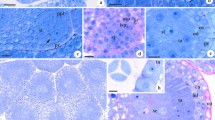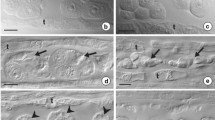Abstract
Micro- and megasporogenesis as well as male and female gametogenesis in genus Agapanthus are reported for the first time. The results are as follows: The anther wall, whose development is of dicotyledonous type, consists of four layers: the epidermis, the endothecium, one or two middle layers, and the secretory tapetum. Fibrous thickenings are developed in the endothecium when shed. Successive cytokinesis during microsporogenesis results in a decussate tetrad of microspores. Ellipsoidal pollen grains are 2-celled when anthers dehisce, with monosulcate extending to polar area; pollen ornamentation is pitted and reticulate. Ovary is superior and trilocular, with axial placenta. The ovule is anatropous, bitegmic, and tenuinucellate. The archesporial cell below nucellus epidermis functions directly as the megasporocyte. Successive cytokinesis in the megasporocyte usually produces a T-shape tetrad, and the chalazal megaspore of the tetrad develops into a Polygonum-type embryo sac. The systematic significance of embryological characters of Agapanthus is discussed.




Similar content being viewed by others
References
APG II (Angiosperm Phylogeny Group) (2003) An update of the Angiosperm Phylogeny Group classification for the orders and families of flowering plant. Bot J Linn Soc 141:399–436
Ashurmetov OA, Yengalychevai SS, Fritsch RDM (2001) Morphological and embryological characters of three middle Asian Allium L. species (Alliaceae). Bot J Linn Soc 137:51–64
Bjornstad IN (1970) Comparative embryology of Asparagoideae–Polygonateae, Liliaceae. Nytt Mag Bot 17:169–207
Chen JH (2003) Research on forestry development based on the urban ecology environment construction (in Chinese with English abstract). Northeast Forestry University, China
Cui GM, Yang LL, Sun Y, Zhang YQ (2008) Correlation study between bud length and gametophyte development stage in daylily (Hemerocallis hybridus cv. ‘Stella de oro’). Acta Bot Bor Occid Sin 28:1983–1988
Davis GL (1966) Systematic embryology of the angiosperms. Wiley, New York
Devi TT, Borua PK (1997) Meiotic behaviour and pollen fertility in three species of Zephyranthes (Amaryllidaceae). Biol Plantarum 39:355–360
Duncan GD (2005) Agapanthaceae—synonymy in Agapanthus. Bothalia 35:87–89
Ekici N, Dane F (2008) Cytological and histological studies on female gametophyte of Leucojum aestivum (Amaryllidaceae). Biologia 63:67–72
Fay MF, Chase MW (1996) Resurrection of Themidaceae for the Brodiaea alliance, and recircumscription of Alliaceae, Amaryllidaceae and Agapanthoideae. Taxon 45:441–451
Furness CA, Rudall PJ (1998) The tapetum and systematics in monocotyledons. Bot Rev 64:201–239
Furness CA, Rudall PJ (2001) Pollen and anther characters in monocot systematics. Grana 40:17–25
Hao LZ, Yang ZR, Wang LY, Zhao QY, Zhang FL (2005) Observation on flower’s morphological and anther’s anatomy character of three Allium plants. Bull Bot Res 25:277–280
He TH, Rao GY, You RL (2000) Reproductive biology of Ophiopogon xylorrhizus (Liliaceae s. l.): an endangered endemic of Yunnan, Southwest China. Aust J Bot 48:101–107
Herr JR (1984) Embryology and taxonomy. In: Johri BM (ed) Embryology of angiosperms. Springer, New York, pp 645–696
Holford P, Croft J, Newbury HJ (1991) Structural studies of microsporogenesis in fertile and male-sterile onions (Allium cepa L.) containing the cms-s cytoplasm. Theor Appl Genet 82:745–755
Hu SY (2005) Reproductive biology of angiosperms. China Higher Education Press, Beijing
Hu SY, Xu LY (1990) A cytochemical technique for demonstration of lipid, polysaccharides and protein bodies in thick resin sections. Acta Bot Sin 32:841–846
Huang JL, Hong DY (1996) Pollen morphology in the subtribe Aspidistrinae (Liliaceae s.l.). Acta Phytotax Sin 35:117–124
Johri BM, Ambegaokar KB, Srivastava PS (1992) Comparative embryology of angiosperms, 2 volumes. Springer, New York
Lan K, Wang RX, Li FY, Li GZ (2008) Mega–microsporogenesis and the development of female–male gametophyte in Aspidistra retusa. Guihaia 28:755–758
Leighton FM (1965) The genus Agapanthus L’Héritier J S African. Bot Suppl 4:1–50
Li P, Zheng XJ, Huang X (1989) Investigation on embryology of Ophiopogon japonicus (L.f.) Ker-Gawl megasporogenesis, megagametogenesis, microsporogenesis, microgametogenesis and changes in polysaccharides. Journal of Sichuan University Science Edition 26:101–109
Li L, Liang HX, Peng H, Lei LG (2003) Sporogenesis and gametogenesis in Sladenia and their systematic implication. Bot J Linn Soc 143:305–314
Liu ZW, Xiao DX, Zhang L, Lian FQ, Tu SP (2006) Microsporgenesis and development of male gametophyte in Lycoris radiata Herb. Acta Agriculturae Universitatis Jiangxiensis 28:234–238
Meerow AW, Fay MF, Guy CL, Li QB, Zaman FQ, Chase MW (1999) Systematics of Amaryllidaceae based on cladistic analysis of plastid rbcL and trnL-F sequence data. Am J Bot 86:1325–1345
Mor Y, Halevy AH, Kofranek AM, Reid MS (1984) Postharvest handling of lily of the Nile flowers. J Am Soc Hort Sci 109:494–497
Musiali K, Bohanec B, Jakse M, Przywara L (2005) The development of onion (Allium cepa L.) embryo sacs in vitro and gynogenesis induction in relation to flower size. In Vitro Cell Dev Biol-Plant 41:446–452
Palser BF (1975) The base of angiosperm phylogeny: embryology. Ann Mo Bot Gard 62:621–644
Penet L, Nadot S, Ressayre A, Forchioni A, Dreyer L, Gouyon PH (2005) Multiple developmental pathways leading to a single morph: monosulcate pollen examples from the Asparagales. Ann Bot 95:331–343
Penet L, Laurin M, Gouyon PH, Nadot S (2007) Constraints and selection: insights from microsporogenesis in Asparagales. Evol Dev 9(5):460–471
Qin WH (2004) The systematic studies on the genus of Lycoris Herb in China (in Chinese with English abstract). Anhui Normal University, China
Rao GY, Pan KY (1995) Embryological studies in Polygonatum humile Fisch ex Maxim. Acta Phytotax Sin 33:444–452
Ren XF, Zhou SB, Zheng Y, Guo XH (1995) Studies on the pollen morphology of the genus Lycoris in China. Acta Bot Yunnanica 17:182–186
Rudall PJ, Furness CA, Chase MW, Fay MF (1997) Microsporogenesis and pollen sulcus type in Asparagales (Lilianae). Can J Bot 75:408–430
Shen JH, Shen Y, Wang YJ, Yuan QH, Yu CG (2006) Megasporogenesis, microsporogenesis and development of female and male gametophyte of Hemerocallis citrine Baroni. Acta Hortic Sin 33:38–45
Shu P, She ML (2001) Pollen photographs and flora of Umbelliferae in China (in Chinese). Shanghai Scientific & Technical, Shanghai
Suzuki S, Supaibulwatana K, Mii M, Nakano M (2001) Production of transgenic plants of the Liliaceous ornamental plant Agapanthus praecox ssp orientalis (Leighton) Leighton via Agrobacterium-mediated transformation of embryogenic calli. Plant Sci 161:89–97
Tian HQ, Yang HY (1991) Embryo sac development and embyrogeny in Allium Tuberosum. J Wuhan Bot Res 9:5–12
Tobe H (1989) The Embryology of angiosperms: its broader application to the systematic and evolutionary study. Bot Mag (Tokyo) 102:351–367
Winiarczyk K, Kosmala A (2009) Development of the female gametophyte in the sterile ecotype of the bolting Allium sativum L. Sci Hortic 121:353–360
Wu J, Chen LJ, Gu L, Wang YY, Tian HQ (2005) Embryological studies on Narcissus tazetta var Chinese. Journal of Xiamen University (Natural Science) 44:112–117
Xiong ZT, Chen SC, Hong DY, Luo YB (1998) Pollen morphology and its evolutionary significance in Hemerocallis (Liliaceae). Nord J Bot 18:183–189
Zonneveld BJM, Duncan GD (2003) Taxonomic implications of genome size and pollen colour and vitality for species of Agapanthus L’ Héritier (Agapanthaceae). Plant Syst Evol 241:115–123
Acknowledgments
The authors are highly grateful to the School of Agriculture and Biology of Shanghai Jiaotong University for providing field and laboratory facilities. This study enjoyed generous support from the Research Fund for the Doctoral Program of Higher Education of China (200802250010), National Science Fund of China (30571475), and the Key Project of the Shanghai Agricultural Committee (2006-4-9).
Author information
Authors and Affiliations
Corresponding author
Rights and permissions
About this article
Cite this article
Zhang, D., Zhuo, LH. & Shen, XH. Sporogenesis and gametogenesis in Agapanthus praecox Willd. orientalis (Leighton) Leighton and their systematic implications. Plant Syst Evol 288, 1–11 (2010). https://doi.org/10.1007/s00606-010-0280-7
Received:
Accepted:
Published:
Issue Date:
DOI: https://doi.org/10.1007/s00606-010-0280-7




